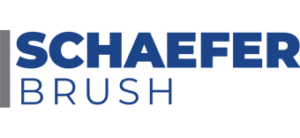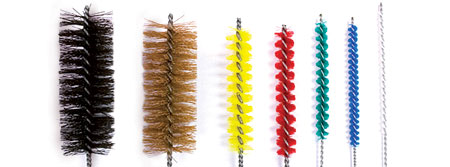Industrial brushes are manufactured with filaments specifically made to help you with industrial and commercial debris removal and cleaning. At Schaefer Brush, we ensure that each brush is crafted using industrial quality and long-lasting filaments with tradesmen, manufacturers and maintenance professionals in mind.
Choosing the right brush filament can seem daunting at first, especially with so many options available from which to choose. We’ve crafted a list of different brush filament options for you so that you can decide which brush is the best fit for you!
Abrasive Nylon Industrial Brush Filaments
-
Aluminum oxide
- Aluminum oxide offers higher impact resistance as compared to silicon carbide. It is the preferred filament for finishing soft metals and other materials where a smooth finish is required.
-
Silicon carbide
- Silicon carbide is more aggressive than aluminum oxide due to the fact that it’s harder and sharper. The filament type offers a more uniform wear and distribution of abrasive grain. This also gives a consistently smooth finish, fewer breakages compared to wire, increased throughput, and a longer brush life due to lighter work pressure.
-
Silicate
- Silicate is a fine-grade abrasive that is used for fine finishing and cleaning. It is commonly used in miniature twisted-in-wire brushes to aid in cleaning and removing debris.
Natural Industrial Brush Filaments
-
Horsehair
- Horsehair fibers are commonly used and are created with mane or tail hairs, each of which provides a different stiffness and texture. This brush filament is best for polishing surfaces without scratching and can easily be mixed with other natural, synthetic, or wire materials to create a custom brush.
-
Boar’s Hair
- Boar’s hair is obtained from pig or boar and can be used in both artist and industrial brushes. It has naturally splitting ends that can carry and transport liquids while maintaining its shape and stiffness over a long period of time. One of the more common names being Chungking bristle.
-
Ox Hair
- Ox hair is an artist brush fiber and comes from the ears of cattle or ox. This brush filament is silky to the touch, yet strong, springy and resilient that is more rigid and stiff as natural bristles.
-
Sable
- Sable is made from the hair of weasels and is springy and soft to the touch. It usually forms a point, allowing the professional to have more precise control. This filament is more of an expensive, high-quality choice that is resilient to solvents and chemicals found in oils.
-
Palmyra/Bassine
- Palmyra/Bassine is made from Borassus Flabelliformis, which is a palm native to Southern Asia. The fibers are coarse and can only be used when damp. This brush filament is known for its durability and long-lasting qualities. It has high water absorption and is resistant to heat, most chemicals, alkaline and acidic solutions.
-
Tampico
- Tampico is most commonly obtained from the agave plant and can hold water, has excellent biodegradability and heat and chemical resistance. Tampico’s natural color is off white. It’s versatility makes it a great fiber of choice.
-
Union
- Union is a blend of tampico and palmyra fibers which create a strong and durable fill that has excellent water absorption qualities. It continues to gain widespread use because of its resistance properties and long-lasting lifespan.
Synthetic Industrial Brush Filaments
-
Nylon
- Nylon comes in a variety of different filament options that range in color, texture and diameter. It is best suited for wet conditions due to its high absorption rate and stiffness. Nylon has the highest heat deflection temperature in comparison to other brush filaments available for you to choose from, but it can become brittle after long exposure to high temperatures.
- Nylons are graded by their water resistance. Type 6, Type 6.6 and Type 6.12 respectively.
-
Polypropylene
- Polypropylene is excellent with wet stiffness and flex fatigue resistance. It is good for most solvents, oils and chemicals, and is good at resisting strong acids and bases. This filament has limited natural sunlight resistance which can be improved with a black colored filament. Polypropylene can be made with different textured fibers and diameters that improve surface contact and liquid retention.
-
Polyester
- Polyester has an improved abrasion resistance in comparison to polypropylene. This brush filament is also more resistant to sunlight and has excellent bend recovery. It is solvent resistant and also handles high temperatures well. This fiber doesn’t absorb much water making it ideal for wet applications. Polyester can also be made with different textures and diameters.
-
Aluminum Oxide
- Aluminum oxide is perfect for abrasive applications. This brush filament holds great stability to heat and chemicals making it an excellent choice for heavy duty applications.
-
Ceramic Grit
- Ceramic grit is the most aggressive grit type that fractures easily to create sharp edges. It is used in a wide range of abrasive applications such as deburring, polishing and sanding. This filament has a long-lasting lifespan.
Wire Industrial Brush Filaments
-
High-Carbon Steel
- High-carbon steel is heat-treated and strong with high fatigue resistance. This brush filament type can be available in different diameters to meet the needs of the brush for the job.
-
Stainless Steel
- Stainless steel is extremely tough and great for corrosion resistance. Different types are available to customize the brush to your exact job. This filament can range from assisting you with welding characteristics to elevated temperatures for highly contaminated applications.
-
Brass
- Brass is a softer wire in comparison to high-carbon steel and stainless steel. It is highly conductive for reducing static in concentrated areas. This filament is corrosion resistant and great for cleaning scratch susceptible surfaces due to its softness.
-
Phosphorous Bronze
- Phosphorous bronze has good fatigue life, high electrical conductivity and corrosion resistance. It is a stronger option in comparison to brass, better assisting with corrosion resistance.











